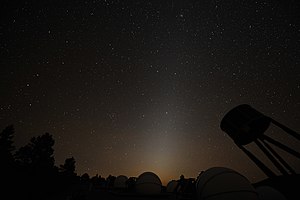 zodiacal light reflecting off dust in solar system (Photo credit: Wikipedia)
zodiacal light reflecting off dust in solar system (Photo credit: Wikipedia)
Many people may be away from home for the Pesach holidays, perhaps even at dark sky locations. If so, look to the west shortly after nightfall to see the elusive
Zodiacal Light. It is a bright pyramid shaped cone, wide at the bottom near the horizon, tapering to a peak at the top. It will be marked by a line connecting the bright planets
Jupiter, closer to the horizon, and
Venus to the above left. The line conecting these two planets passes through the
ecliptic, the plane of the earth's orbit around the sun. The other planets and our moon lie within a 5 degree radius of the ecliptic, so they are never far from it. The ecliptic is called the Zodiac by astrologers, and for the same reason the sun, moon, and planets are always found within the
constellations of the Zodiac.
Tonight Jupiter is in Aries and Venus is in Taurus, Venus having just put on a magnificent show passing the star cluster, the
Pleiades, last week. The Zodiacal Light is a dim, elusive cone of light that is the reflection of sunlight from billions of grains and dust that lie in the plane of our solar system. The earth is constantly bombarded by these throughout the day and night, but most are too small to show as meteors. Consider them to be motes of cosmic, solar system dust that light up as they reflect the light of the sun at evening. Now is the best time of year to observe the Zodiacal Light, since the plane of the ecliptic makes an almost 90 degree intersection with the horizon, lifting the Zodiacal Light high in the sky and making it readily visible from dark, clear skies. The path of the ecliptic is marked by Jupiter and Venus, so the zodiacal light should appear along the line connecting them. Go outside and have a look and let us know if you can spot the Zodiacal Light. When you do, remember you are seeing a light show put on by the dust that fills the plane of the planets' orbits around the sun.

The Zodiacal Light, as it appears along the line connecting Jupiter and Venus, shortly after dark tonight, April 8, 2012









